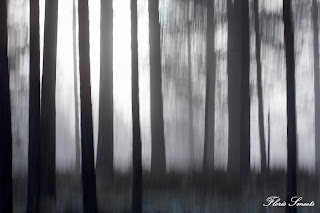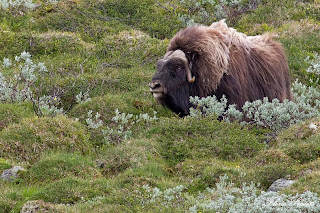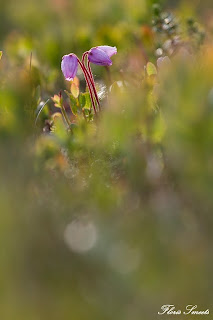It has been
a very long time since my last post on my blog. That doesn’t mean that I have
been sitting still. The opposite is more true… I have been very busy.
After my
first guest photographers left, in the end of April, I returned one more time
to my favorite black grouse display area to do something which I have had in my
mind for a quite some time…photographing the black grouse against the morning
light. I put my tent on the other side of the display area as I normally do and
was expecting the birds on their usual positions. However, in the early morning
some female black grouse appeared scattered around the bog. With as result that
all males were running around and were not sticking to their usual places. And
when the first sun light started to come over the mountains there was not a
single bird between me and the sun. But when the first strong orange beam of
light came over the mountains, one of the males suddenly made 50 meter run and
stopped exactly between the sun and me. PERFECT!
I managed to get the shots I
was hoping for. Afterwards I took some more shots of the birds with the light
from behind.
This is something which I will do again next year for sure and can
advise my guest photographers to do too.
After this
last visit at this display area, I spent the early mornings looking for new
display areas for the upcoming years. I want to offer my guest photographers
the possibility to photograph the birds in different settings. And by using
multiple areas the disturbance is minimalized. I found a couple of new display
areas, including one where the males are displaying in the tops of the trees.
One morning
there was very dense fog in the forest which pushed my creativity forward and
made me make this shot.
My trusty
Canon 40D started to show more and more problems with focusing and the shutter bottom
did not work always anymore. Canon estimates that this body will be able to
make about 100.000 clicks, mine has almost reached 135.000 now…. Time for a new
camera! I really want the Canon 1D mark IV, but my bank account does not allow
that. So I had to settle for the 7D, which is a big upgrade from the 40D.
Now the
grouse display season had passed I had to look for a new subject to photograph.
I didn’t have to wait long. One evening I was driving home when I saw something
what made my heart beat faster. There was a great grey owl sitting right next
to the road. Great grey owls are rarely found in Norway, so this was a special
situation.
I decided
to keep my finding a secret since I didn’t want everyone to go to this area
looking for the owl. But I spoke about it with a researcher who informed me
that there was a record number of breeding Great grey owls in Norway this year.
And it didn’t take too long before the first Great grey owl pictures from this
area started to appear on the internet. But I didn’t have the time to go out
and photograph the owls. The weather got so bad that the valley flooded. Roads,
fields and houses were under water, so
no chance to go out. The flood gave me some nice shots doe. Luckily, just
before the flood flooded the roads, my new camera arrived.
When the
flood went down, the university of Hedmark hired me as guide for a group of
forest, nature and wildlife managers from Scotland. We had an amazing week, saw
many things, learned a lot from each other and had a lot of fun. It was an
amazing experience for all of us. We saw beautiful sunsets, landscapes and a
large variety of wildlife such as moose, musk-ox, reindeer, red deer, roe deer,
short eared owl, golden eagle, hen harrier, cross beak, red shank, green shank,
sand piper, wood cock, black throated diver, grey headed wacktail, capercaillie
and many other species. We visited the Norwegian forestry museum in Elverum,
went to Dovrefjell where two rangers of the national park informed us about the
management of the park and took us for a short trip to their reindeer
observation post. We stayed at a traditional Norwegian farm where we were served
with typical Norwegian food. We found a wolf kill, visited a bear den, joined
one of the grouse researchers into the field and placed a camera trap at a
capercaillie nest and went fishing. In between there was a day where the Scots
presented their field of work at the university of Hedmark and where some
researchers of the university presented their field of work. Additionally, the
university arranged meetings with a wildlife manager and a large forest owner.
As you can see we had a full schedule.
This week
made me realize that I also want to guide not just photographers but also other
people with interest in nature, wildlife and forestry.
The evening
which I came back home, I found out that a couple of long eared owls was using
the field behind my house to hunt. I observed the birds one evening and set up
a camouflage net on a tactical place. The next few days I spent quite some
hours behind the camouflage net. Here I really got to test my new camera. Sadly
enough I didn’t know all the servo tracking settings yet and had the wrong
settings when a long eared owl flew straight at me up to just 1.5 meter
distance! Too bad! However, I managed to get some nice shots of the two owls.
I only had
a few days with the long eared owls, because I had a flight to catch. I went
back to the Netherlands for 2 weeks to visit my family and friends. Of course I
took my camera with me. I spent some time at a nature area close to my parents
place and spent one morning in the photo hut of Hans Menop in order to
photograph the Little owl.
When I came
back from the Netherlands, I didn’t waste any time. I packed my backpack and
went for two days to the Great grey owl area, together with a friend of mine.
It didn’t take us long before we found the first owls. It was a couple with two
chicks. We managed to photograph them at night with long shutter time.
In the morning we witnessed one of the parents feeding a chick with a vole.
Amazing!!!
After this trip I spent some more days in the area and managed to
find a total of 13 owls! I can’t wait until the winter to get shots of the owls
in the snow.
It is
expected that many of the owls which were breeding in this area, will also
breed here again next year. If this is true, I will organize guided trips to this
area next year.
After the
Great grey owl chicks started to fly, it really became time to work on my
master again. I would almost forget that I’m still studying. However, I didn’t
lock up my camera.
Between studying and sleeping I have been making short trips closer around
the house for some small birds and beaver, went one weekend into the mountains
and guided one of my nephews and his girlfriend through Dovrefjell in order to
find musk-ox and reindeer antlers. We found 37 musk-ox in a short trip. Most
groups had young animals, so we stayed on long distance. However, I spotted 3
bulls grazing together a bit further in the area. These we could approach a bit
closer and observe nicely for some time.
With the reindeer antlers we were not
so lucky. We went off the tracks, over a mountain top into an area which is used
more frequently by the reindeer, but found only heavily damaged antlers.






































































































































